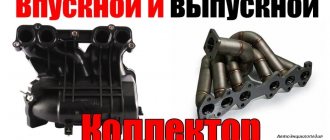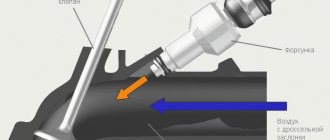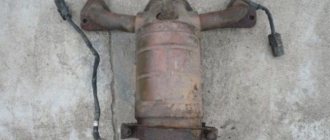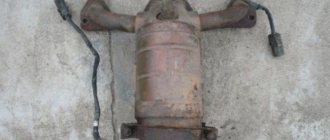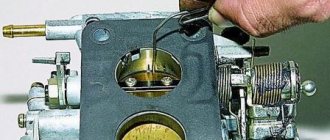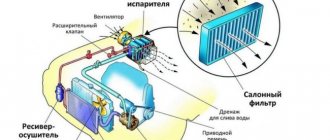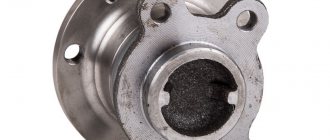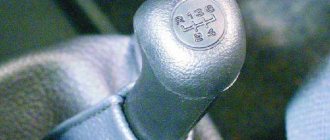Intake manifold removal process
Dismantling the intake manifold is carried out with the car cooled down for safety reasons. So, this operation can take about an hour and will require some knowledge of the car’s design, namely the injection system. So, let's consider the sequence of actions for dismantling the unit:
- We dismantle the throttle. To do this, it is not necessary to disconnect all the pipes and pipes; it is enough to disconnect the unit from the manifold and move it to the side. Of course, at the same time, it is still recommended to remove the throttle valve completely for cleaning.
- Disconnect the throttle cable from the intake manifold.
- Disconnect the wires from the ignition coils. This is easy to do; you just need to disconnect the connectors.
- Disconnect the camshaft position sensor wires.
- Disconnect the wiring harness from the absorber purge valve.
- Disconnect the brake booster hose from the intake manifold.
Unscrew the clamp and disconnect the vacuum brake booster tube
- Unscrew the clamp and disconnect the crankcase ventilation pipe.
Unscrew the crankcase ventilation tube clamp
Unscrew the clamp and pull the tube out of its seat.
- Unscrew the self-tapping screw securing the guide tube of the oil level indicator.
Using a Phillips screwdriver, unscrew the oil level indicator guide tube
- We take out the dipstick along with the guide tube.
Dismantling the dipstick
- Using a socket or a 10mm wrench, unscrew the nuts securing the intake module and the ignition coils of cylinders 1, 2 and 3.
Unscrew the ignition coils and receiver
- We dismantle the ignition coils of cylinders 1, 2 and 3.
- Now, you can unscrew the direct fastenings of the intake manifold to the cylinder head.
Unscrew the bolts securing the manifold to the block head
- Move forward and remove the manifold.
Pull the collector towards you and dismantle it
It is worth noting that installation of the intake manifold is carried out in the reverse order and does not require any additions or changes.
Video
This is interesting: Replacing a windshield is an opportunity to tune a car
Lada Kalina (8, 16 valves): replacing the catalyst with a spider or flame arrester
These are: fuel system, exhaust gas recirculation system. After a run of 80-100 thousand km, the metal housing of the exhaust manifold begins to crack at the seams.
Flange connections are torn away from their seats.
Replacing a catalyst with a spider, as a process, is divided into several stages.
This does not take into account the fact that the catalyst itself needs to be changed due to burnout of internal parts due to systematic contact with a hot flame flow. The average gas temperature reaches 600℃.
So, division into stages: collecting data on the number and location of catalysts in the car; preparation of spare parts in each specific case for modification;
Device
Although from the outside the intake manifold appears to be just a pipeline of a specific shape, in fact a whole team of engineers works on its geometry, calculating the cross-section, length and volume.
Plus, it includes:
- Throttle valve;
- Supply chamber;
- Air filter;
- Inlet valve;
- Discharge chamber.
For engines with distributed fuel injection, injectors are additionally installed in the intake manifold, due to which the mixing of fuel and air masses occurs directly in the discharge chamber.
The pipeline itself can combine from 2 to 12 channels, depending on the number of cylinders in the engine block. At the same time, for a 4-cylinder engine, a manifold with three pipes is sometimes used.
It is also worth noting that most modern intake manifolds over the past 5 years have been made from special high-temperature plastic, while the exhaust manifold can still only be made from metal.
Preparation
VERY IMPORTANT
!
Disconnect the positive wire of the engine under the red cap 1 photo 1
so as not to short anything! And do this with every repair or disassembly in the engine compartment. So, let's begin. What do we need to remove the intake? First of all, remove the plastic decorative cover of the motor (it is mounted on four supports
1 photo 3
).
Sometimes it sits very tightly on its bushings, so there is no need to rip it up madly. It is enough to pick up the lid with one hand, and with the other push the support from the rubber seat 1 photo 2
up from below.
Below it is the air filter housing. It also comes off easily. We remove the chip from the flow meter
1 photo 4
and unscrew
the screw clamp 2 photo 4
with a head on 6 with a small ratchet.
Afterwards, this entire assembly can be removed entirely by pulling up the filter housing from the rubber supports 2 photo 2 and photo 3
in front and towards you to remove it from the supports at the back.
Pulls out without difficulty. You can remove the filter housing separately by unhooking the flow meter snorkel 3 photo 3
from it.
What are swirl flaps used for?
As you know, it is not the fuel itself that burns in the cylinder, nor the air. The air-fuel mixture is burning. And the more homogeneous this mixture is, the better it burns, the higher the efficiency and economy of the engine. Accordingly, the question arises: what is the best way to mix this very fuel in the cylinder? Nozzles that supply fuel not with one large and thick stream, but even with a dozen small streams protrude from one side. And on the other side we have air supplied. And if this air is applied with force, and even at a tricky angle, you get a whirlwind. Which will mix everything perfectly and burn just as well.
But then the engineers faced a question: if they make the hole for the air supply narrow, then at low speeds the vortices will be excellent. But when the speed increases, too much air deficiency will form and too much energy will be spent on its supply. If you make the hole wide enough to operate at medium and high speeds, then there will be no swirl at low speeds, and the engine efficiency will again decrease.
Therefore, for optimal engine operation in all modes, the air supply was divided into 2 parts. In one part there are no dampers, and it is always freely blown, while the second part has the same damper that is completely closed at low revs and opens wider the higher the revs.
The figure shows a diagram of the operation of swirl flaps at low speeds. Air is supplied through only one channel. The second channel is completely closed.
As the engine speed increases and the engine requires more air, the second damper gradually opens slightly, controlling the strength of the air flow. A fully open throttle at high speeds is shown in the figure below:
The position of the swirl flaps is controlled by an integrated sensor and a corresponding drive that changes the angle of inclination of these flaps.
To shoot or not to shoot?
So, you are faced with the final failure of the catalyst and the impossibility of resuscitating it. Should I delete the device or not?
- Without it, the quality of the exhaust deteriorates: it begins to meet EURO 2 standards. It is believed that this makes it difficult to undergo maintenance. However, this argument seems dubious to us: catalysts are installed only on injectors, and besides, cars are necessarily electronic. Somehow, Ladas from 1 to 7 models undergo technical inspection;
- The car’s power begins to surpass previous figures, which will be a balm for the owner’s soul.
- We also add lower fuel consumption as a plus. The reduction sometimes reaches 10-15%;
- In terms of cons, the list turns out to be quite impressive. First of all, this is an almost 100% occurrence of errors in reporting and a continuous lighting of the Check engine. Some may be indifferent to this, some will be annoyed by it, but the main thing is that there is a possibility of missing a serious warning about other problems in the car;
- The muffler will work worse. Moreover, it will burn out faster, since exhaust gases with an unacceptably high temperature will begin to break into it. Plus the exhaust will have a loud and unpleasant sound. Fire is likely to appear from the exhaust pipe;
- The engine will become noisier; Vibration is likely to be transmitted to the interior.
In our opinion, the pros and cons of catalyst removal are combined with the predominance of the latter. It will be completely insufficient to simply cut it out: too much is lost. At a minimum, you will need a flame arrester instead of a catalyst. And to remove the constant Check engine reminder, you also need to install a decoy lambda probe like “Stronger”.
Moreover, in many cases, blende is not enough, and the issue has to be resolved by installing a series RC filter. All the work taken together, even if carried out with the participation of auto experts, still turns out to be cheaper (and much!) than a new catalyst. However, before it breaks, it is still better to take care of it so that it lives as long as possible.
Check Engine
Often, a decent amount of air leaking through the joints of the intake pipe even causes the Check Engine indication to appear.
The corresponding error code will indicate that the air-fuel mixture is too lean. Other culprits for this problem are worn gaskets at the junction of the pipeline and the cylinder head. Often, a decent amount of air leaking through the joints of the intake pipe even causes the Check Engine indication to appear. The corresponding error code will indicate that the air-fuel mixture is too lean. Other culprits for this problem are worn gaskets at the junction of the pipeline and the cylinder head.
Constructive
Metal intake manifolds are cast as a single unit or made into multiple parts. In the latter case, the connections are sealed with sealant or gaskets are installed. Accordingly, they can always be updated by halving the composite manifold.
Plastic collectors are always composite. Production technologies do not allow producing such units as monolithic ones. In most cases, such collectors are actually non-separable: the joints of the connections are soldered. Although there are still more thoughtful designs with the ability to painlessly separate into parts and replace rubber gaskets.
Action plan
As a rule, the joints of plastic elements are more capricious. If the collector is dismountable, then its tightness can be easily restored. True, in most cases the assembly has to be removed from the engine. And in the case of a “monolithic” collector, you will have to think about ways to seal it.
The most reliable option is plastic welding. This is a technology that, for example, is used to repair cracks and tears in bumpers. However, this option can be expensive when it comes to large restoration areas. In this case, it is sometimes cheaper to buy a new or used manifold. If you do this on your own, you will have to spend money on expensive equipment: a special construction hair dryer and a Dremel (straight grinder or drill).
A simpler option is to arm yourself with a soldering iron and solder a plastic seam onto the joint. For example, pieces from a plastic measuring bucket for liquids are suitable for this. All you really need here is patience.
The quickest and easiest way is to seal the joints with sealant. True, this method is least preferable for supercharged engines. Their intake air pressure in some operating modes is significantly higher than that of atmospheric engines. Therefore, any sealants can weaken, and soldering is more suitable for a supercharged engine.
Replacing the gasket
The marker of a failed gasket is considered to be soot that forms in the place where the exhaust escapes. In this case, proceed to replacing the defective seal.
What is needed for repair
To replace the exhaust manifold gasket, prepare the following materials and tools:
- screwdrivers (slotted and Phillips);
- sharp knife or spatula (remove used gasket);
- spanners included;
- anti-rust liquid (for example, WD-40);
- 5 liter wide-neck container (for draining antifreeze);
- dry rags.
ATTENTION! When replacing the manifold gasket on a VAZ 2114 (as on other factory models), it is necessary to drain the antifreeze in advance, otherwise the engine intake windows can be flooded.
Step by Step Actions
The process of replacing a seal when it fails is simple, but has nuances for different engines. In general terms, the algorithm for dismantling and subsequent installation of the VK gasket looks like this:
- Open the hood and remove the air intake with the carburetor, under which there is a manifold.
- Remove the thermal screen covering the VC (some older models do not have a screen).
- Unscrew the bolts that attach the spider to the exhaust pipe, and then the bolts connecting it to the engine block.
- Proceed to removing the exhaust manifold itself, on which sits a burnt-out gasket, which often “sticks” to the VC.
- Carefully clean the area between the cylinder head and the manifold with a spatula, removing carbon deposits and fragments of worn gasket from the second.
- Once the area is shiny, coat it with graphite lubricant and install a new gasket.
- Treat the fasteners with the same lubricant (to prevent corrosion).
Finally, return all dismantled parts to their rightful places.
Tuning
Tuning and changing geometry are two different things. When people talk about modifying the intake manifold, they usually mean increasing the incoming air volume and reducing the resistance along its path.
For this purpose the following procedures are provided:
- Replacing the air filter with a zero resistance filter. Thanks to the macroscopic holes in the latter, air is retained less and, accordingly, the speed and volume of passage increases;
- Enlargement of the throttle pipe. It also aims to increase air permeability. Usually, for this purpose, a damper is installed from another engine, which is more powerful than the original;
- Installation of a sports receiver. Short tubes with a larger cross-section, when properly configured, can reduce the pulsation of air masses, which allows the engine to gain speed faster.
There is also a tuning option when the intake manifold is completely removed and short pipes tuned to high speeds are installed instead. This option is provided only for naturally aspirated engines and is called a multi-throttle intake (that is, each cylinder essentially has its own manifold).
By the way, any changes in the intake system usually entail upgrading the exhaust manifold, camshaft and firmware of the electronic control unit.
This is interesting: Antifreeze - domestic antifreeze in all its details
What we do
To work with Bavarian diesel engines, you will need to quickly and skillfully remove not only the plastic under the hood, but also the intake manifold. This skill will save a lot of time, since most maintenance and repair operations on such motors are based on this unit.
Let me say right away that the ability to quickly and correctly remove and install
any part
will make your repair high-quality and successful without any undesirable consequences!
In this note I will try to describe in detail the process of removing the intake manifold using the example of the 3-liter diesel inline six N57 40d of the first version of the engine on the X5, X6 crossovers in the E70 and E71 body.
.
It is on all-wheel drive cars that there are additional tubes on the EGR
for heating the transmission oil and a hidden vacuum hose connected from below to the receiver, which is located in the manifold.
Essentially on four-cylinder N
series, everything is done exactly the same and even easier in some places, if you don’t take into account the additional disassembly of plastic boxes.
The process of removing the collector on this series is radically different from its predecessor M57
, which can be found
here
.
Malfunctions
Like any other mechanical part, the intake manifold is susceptible to failure. Given the simplicity of the design, there are not many options for malfunctions.
Basic:
- Violation of tightness. Vibrations, pressure and high temperatures destroy seals over time. Depressurization affects the quality of the fuel mixture, loss of traction and speed. The problem is solved by replacing the gaskets, after which engine operation should return to normal;
- Collector contamination. Plaque accumulates on the walls, gradually reducing the cross-section of passing air masses. Requires disassembly and cleaning of tubes, throttle and discharge chamber;
- Mechanical damage. If the collector is made of plastic, it is only a replacement. If it is made of aluminum and the damage is small, argon arc welding will help;
- Excessive temperature in the manifold. There are a lot of reasons and you need to look for them in the cooling system, clogged radiator, damaged sensor, ECU error. Also, high temperature occurs due to the banal heat outside;
- "Clap." When forming the fuel mixture, the system must be sealed. If there are disturbances in the ignition system, the gas distribution mechanism, problems in the fuel mixture formation chamber, or the tightness of the intake manifold itself is broken, you can hear those same pops. It is worth looking for reasons in all of the above places.
In the latter case, of course, it is easier to rely on the errors reported by the ECU or sign up for a comprehensive diagnostic service.
When to change: self-diagnosis
The fuel system of an injection engine has a fairly extensive architecture and faults can only be identified after an accurate diagnosis of each of the system elements. For example, a drop in engine power may be the result of either a malfunction of the injectors, insufficient performance of the fuel pump or a clogged fuel filter.
In addition, jerks and dips, unstable idle and difficult starting, increased consumption, can occur when the injector is simply clogged.
You can check the injectors themselves directly on the engine without removing them. To do this, just start the engine and remove the wires from the connector one by one. If the stability of the engine changes at the same time, the engine starts to oscillate, then the injector is in order. If, when removing the wires from the connector, the stability of the motor does not change, the injector needs to be cleaned or replaced.
Sources
- https://rmo-ru.ru/dvigatel/vpusknoj-kollektor-na-vaz-2112.html
- https://ilifia-club.ru/dvigatel/kak-snyat-vpusknoj-kollektor.html
- https://avto-mekhanik.ru/dvigatel-i-navesnoe/kak-snyat-vpusknoj-kollektor-na-vaz-2112-16-klapanov-plastikovyj.html
[collapse]
Lada Kalina from ZR park
Lada Kalina 2 from the ZR park
Lada Kalina 2 from the ZR park
Are there any volunteers?
Armed with theory, we will repair the intake system on the editorial Kalina. The composite plastic path of the 1.6 naturally aspirated gasoline engine (106 hp) leaks around the perimeter of the wells for the ignition coils. Apparently, these are the consequences of frequent tests on the Smolensk Ring race track, in which the car and especially its engine were driven to the limit of their capabilities.
Is there an alternative
Will Priora work without a catalyst? Of course it will be! The absence of a catalytic converter will not affect its performance in any way, as some “experienced” craftsmen claim. Yes, the car will no longer meet established environmental standards, but it will not work any worse.
If you don’t want to spend money on a standard catalyst, you can always buy a universal device, which will cost you half the price, taking into account installation. Essentially, it is the same catalytic converter with the same functions and similar design. And they are produced mainly in the same factories as the original ones, and their price is lower due to the absence of various trade markups.
Well, if you want to easily tune your Priora, buy a good flame arrester for it. It is installed instead of a catalyst. With it, the engine power will increase due to improved exhaust gas flow, and the sound of the power unit will acquire sporty notes.
How does he work
The intake manifold is a complex structure that allows fuel and air into the engine.
Upon arrival, they are distributed into streams depending on the number of cylinders in the engine. Moving pistons create a vacuum that reaches a maximum at its lowest point. This creates a virtual vacuum, which neutralizes the crater gases.
The intake system has changed greatly during the evolution of the automotive industry.
So, its structure has come to us in its current form:
- frame;
- air intake;
- pipe branch;
- throttle valve;
- muffler;
- intake manifold;
- pad.
It turns out that the collector itself is part of an important system that ensures the proper functioning of the engine. Its place is on the left side of the cylinder head. To monitor the pressure and temperature inside, sensors are installed on it. The calculations are carried out by the control unit, which also generates commands.
One of the functions of the intake manifold is the redistribution of the fuel-air mixture between the cylinders in the engine.
The main problem for all car enthusiasts was overheating of the intake manifold; for this reason, heated air expands, and its input volumes are significantly reduced. Thus, fuel consumption increased, and the quality characteristics of the engine decreased. Then the technicians decided to make most of the structure from plastic, which alleviated the problem. But still, in order to avoid breakdowns and other troubles, this compartment must be cleaned in a timely manner.
Catalyst Kalina
The reason for this may be malfunction of the starter, low-quality gasoline, or damage to the integrity of the part due to driving on an uneven road.
If a malfunction is detected in the operation of a part, the computer displays the message “Check” on the information panel, which, when deciphered, shows the error “Ineffective operation of the catalyst.”
This is fraught with a decrease in engine power (the car may not pick up speed above 60 km/h) and increased fuel consumption. If you ignore the problem, one day the car may simply not start.
Signs of the need to replace the catalyst on Kalina:
- The car began to consume more gasoline.
- the car began to accelerate worse and lose speed when driving uphill;
- the car exhaust has acquired a black color and a strong unpleasant odor;
- when the engine is running, grinding and knocking sounds are heard from the exhaust gas filter;
Environmental
silicone sealant
Universal silicone sealant.
Most of these tubes are equipped with a convenient nozzle. By cutting off part of the spout, you can select the desired diameter of the hole so that the sealant fits well into the joints. Universal silicone sealant. Most of these tubes are equipped with a convenient nozzle. By cutting off part of the spout, you can select the desired diameter of the hole so that the sealant fits well into the joints.
Ramp
Replacing the cathode collector on a VAZ 2110
The ramp is removed as an assembly with the fuel pressure regulator:
- It is necessary to disconnect the vacuum hose from the regulator.
- Using 2 open-end wrenches 17, unscrew the fittings securing the gasoline supply pipes to reduce pressure.
- Disconnect the ramp voltage connector.
- Using a screwdriver, unscrew the screw of the bracket for fastening the gasoline supply and outlet pipes and disconnect it.
- Using a No. 5 hexagon, unscrew the 2 screws for fastening the ramp.
- Pull the ramp in the axial direction of the injector from the seat, remove the ramp towards the left side of the hood.
Note: follow the direction of travel of the vehicle.
Replacement cathode collector for VAZ 2110
- Unscrew the nut from the left intake manifold bracket and loosen the lower bolt.
- Remove the bracket from it.
- Perform the same operation with the right bracket and remove it.
- Unscrew the 2 nuts from the eye stud.
Required tools and materials
The list of what is needed is, in principle, standard: a standard set of tools, an extension cord with various heads, WD-40 or other similar lubricant. If you know that the problem is broken studs, then a stud extractor, taps, drill and drill bits will be added to the above list. In addition, a bucket or basin, possibly an old canister, should be at hand.
Advice! A few days before replacing the exhaust manifold, you can begin to lubricate all fasteners in the system. Can be lubricated several times a day. This will greatly simplify the task and make replacement quick.

